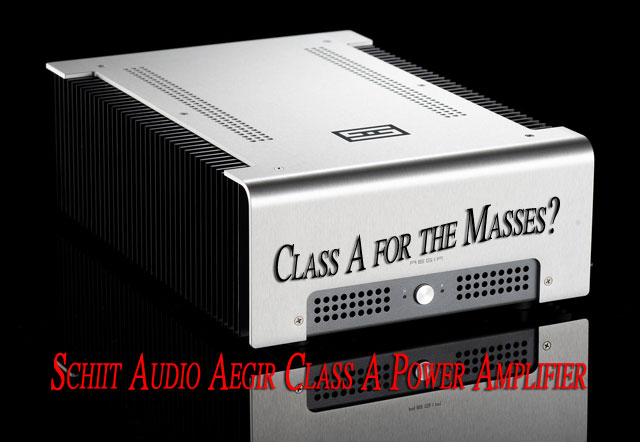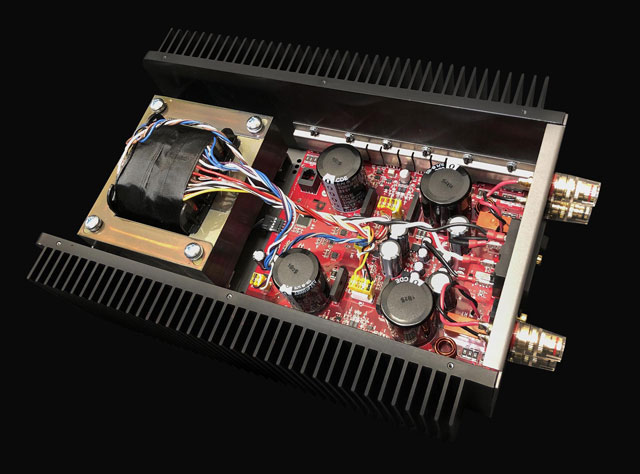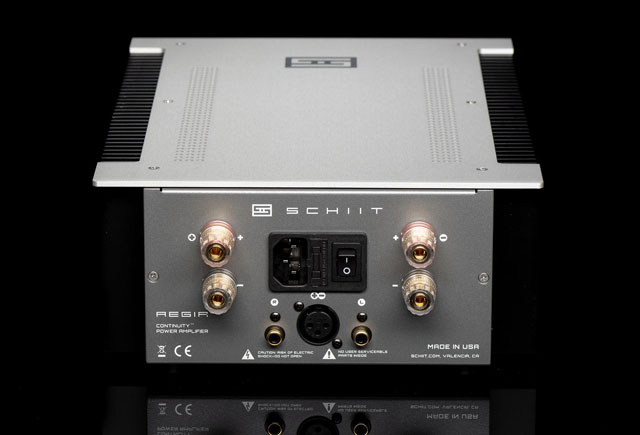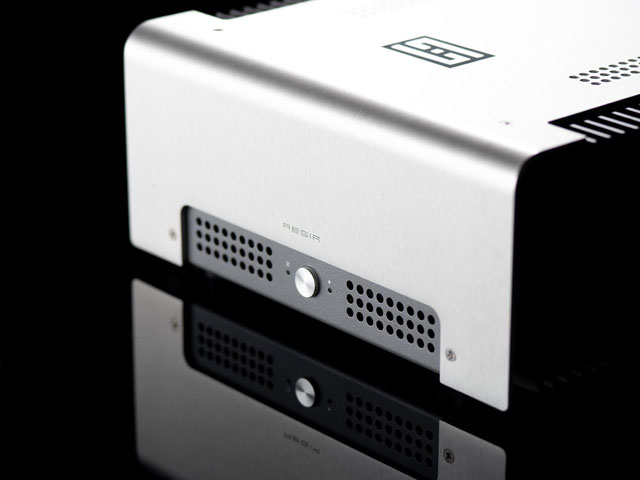Schiit Audio Aegir Class A Power Amplifier

Schiit Audio is the most maverick of a group of companies that have risen to prominence in recent years serving the Computer World market. Initially focusing on small, high-quality inexpensive DAC’s, headphone amps, and other acccoutrements for those whose source of music is their computer and/or their cell phone, and whose listening room is their desktop and headphones, Schiit Audio is, unexpectedly, not the brain-child of hard-core computer geeks. Instead the company boasts principals/founders with firm bona fides in High-End audio (Theta Digital and Sumo Electric.)
Without standard retail Brick and Mortar representation, their Internet-only sales strategy allows them to sell their wares at budget prices. California-based and USA-manufactured, Schiit’s public stance is one of iconoclasm, irreverence, and anti-“High End”-pretense vox populi, reflected in the their choice of name. Their products are often innovative, and they seem to be unafraid to try novel circuit ideas and applications. They’re not a company to hold the apple cart sacrosanct, but are more likely to enthusiastically upset it. Schiit’s product line has expanded through the most recent years to include applications for more conventional 2-channel stereo speaker playback, including preamps, an integrated amp, and 2 power amps, the newest of which is the just-released Aegir. The Aegir is a 20 watt per channel pure Class A stereo amplifier that sells for $799. No, that’s not a typo: it costs $799.
Although more commonly available in tube designs over the years, Class A operation has long been touted as the salvation for transistor amp design. The precursor for the term “Digititis” was “Transistor-itis”, dating back to the first solid-state amps of the mid-1960’s. It meant the same thing: harshness, artificial brightness, glare, pain, and listening fatigue. Class A solid-state design is often prescribed as a panacea for solid-state ills.
 What does Class A offer sonically to justify this premier reputation? A Class A amp keeps its output stage biased and operating on both positive and negative swings of a signal waveform. Class B, on the other hand, uses separate devices for each half of the waveform, each of which has to be turned on and off as the signal passes from positive to negative, and back again. Think of it as similar to the handing-off of a baton in a relay race: any fumbling, clumsiness, or mis-timing will affect the smoothness of the hand-over. In electronic terms it will create crossover distortion as the signal passes through the zero axis. This type of distortion is particularly noxious as it is un-related harmonically to the signal, and is more audible as signal levels drop. Most amplifiers operate in Class A/B in an attempt to ameliorate the difficulties encountered in that crucial transition zone.
What does Class A offer sonically to justify this premier reputation? A Class A amp keeps its output stage biased and operating on both positive and negative swings of a signal waveform. Class B, on the other hand, uses separate devices for each half of the waveform, each of which has to be turned on and off as the signal passes from positive to negative, and back again. Think of it as similar to the handing-off of a baton in a relay race: any fumbling, clumsiness, or mis-timing will affect the smoothness of the hand-over. In electronic terms it will create crossover distortion as the signal passes through the zero axis. This type of distortion is particularly noxious as it is un-related harmonically to the signal, and is more audible as signal levels drop. Most amplifiers operate in Class A/B in an attempt to ameliorate the difficulties encountered in that crucial transition zone.
The UK’s JR Sugden A21 Class A integrated amp (also roughly 20 Watts per channel) has been in production for 50 years. Along with Nelson Pass’s Class A amplifiers, these two brands have proven stalwart examples of Class A design’s merits for solid-state amplifiers.
The enemy of Class A design has always been heat. Because the output devices are always fully-biased, they produce an enormous amount of heat. Thus the amp has to be ‘heat-proofed’ to keep it from melting down/blowing up, raising the price to levels that remove Class A amps from the casually affordable. That Schiit’s Aegir sells for $799 opens access to Class A performance for a whole new group of listeners.
The Aegir produces 20 watts per channel into 8 Ohms, 40 into a 4 Ohm load. Unless one has extremely insensitive loudspeakers, an extremely large room, or is simply eager to become an early candidate for a hearing aid in one’s immediate future, listening at the lower 80’s dB sound-pressure levels –loud enough to hear all the instruments, sense the acoustic of the recording venue and to raise low-level dynamic detail to the level of consciousness – won’t tax the Aegir.


 Schiit Audio calls their circuit design for the Aegir Continuity. They feel strongly enough about this circuit design to trademark it. From what I can gather from their website and its footnotes, Continuity ™ is an attempt to eliminate transconductance phenomena outside Class A biasing, and is a continuation of Class A biasing benefits outside that biasing’s limits. Thus, while the Aegir’s output transistors are Class A-biased for 10 watts a channel, Continuity™ permits Class A performance out to the Aegir’s rated 20 watts (40 into 4 Ohms.). Furthermore, since a pair of Aegirs run as monoblocks (balanced-mode XLR connection only) can produce 80 Watts per channel into 8 Ohms, Schiit claims “Class A-like” performance up to that power level.
Schiit Audio calls their circuit design for the Aegir Continuity. They feel strongly enough about this circuit design to trademark it. From what I can gather from their website and its footnotes, Continuity ™ is an attempt to eliminate transconductance phenomena outside Class A biasing, and is a continuation of Class A biasing benefits outside that biasing’s limits. Thus, while the Aegir’s output transistors are Class A-biased for 10 watts a channel, Continuity™ permits Class A performance out to the Aegir’s rated 20 watts (40 into 4 Ohms.). Furthermore, since a pair of Aegirs run as monoblocks (balanced-mode XLR connection only) can produce 80 Watts per channel into 8 Ohms, Schiit claims “Class A-like” performance up to that power level.
Schiit also proclaim that the Aegir eliminates NPN and PNP transistor mismatches in its output stage. The overall result is still a hot-running Class A amp. Schiit recommends plenty of air-flow around its physical placement, and offers a stand-by switch that de-biases its output to reduce heat output while in interlude.
The amp is a wide bandwidth design and is DC coupled, a micro processor controls the power supply and protects the amps from faults. Hefty in weight, the Aegir’s mass is concentrated in its narrower center; expanded heat sinks flank it. The amp is deeper than wide, making access to the power switch located on its back panel more than a bit clumsy when the amp is placed on the bottom shelf of the average rack. The front panel features a button to switch in and out of stand-by mode, and two side-by-side LEDS, the left of which indicates the amp is de-biased and in stand-by, the right glowing when the amp is active.

The Aegir bloomed sonically at roughly 20 hours of initial active play and never got really hot to the touch.
Warm, but not scalding. I am a denizen of the Great Frozen North where even Spring-time can be decidedly cool, and have long acclimated to room temperatures more akin to English interiors. Since my listening SPL’s rarely exceed the lower 80 dB range, I was able to drive speakers ranging in sensitivity from 83 dB (small-room and near-field only) to 90 dB at my preferred, hearing-preserving, volume levels without ever approaching the Aegir’s limits.
 Class A amplifiers have long been noted for grace, ease, subtlety, fine-detail, and a refined freedom from coarseness, un-natural harshness and brightness, particularly in music’s midrange and treble. The Aegir did not disappoint. Many of the instruments that serve as my acid-tests, which ordinarily bedevil run-of-the-mill transistor amplifiers, were sonically neutral and pure in tone with the Aegir. These included the violin, the trumpet, the trombone, and the piano. Instruments of the Classical orchestra were portrayed with a natural detail that was gratifyingly welcome, but rather unexpected considering the Aegir’s reasonable price. Affordable amplifers usually don’t sound this neutral, natural, and accurate. The difference between violins and violas, particularly in the frequencies where the two instruments overlap, was clear and obvious. Equally well-done was differentiation between French horn and English horn, clarinet and oboe, and cellos and double-basses. In short the timbral reproduction of the Aegir was exemplary, its frequency range continuous and uniform, without favoring any particular band of frequencies. Low bass and the highest treble were equally clear. My wife was particularly taken with the Aegir’s first-rate song lyric articulation. I agree with her wholeheartedly. Garbled lyrics have been my pet peeve with audio components for decades.
Class A amplifiers have long been noted for grace, ease, subtlety, fine-detail, and a refined freedom from coarseness, un-natural harshness and brightness, particularly in music’s midrange and treble. The Aegir did not disappoint. Many of the instruments that serve as my acid-tests, which ordinarily bedevil run-of-the-mill transistor amplifiers, were sonically neutral and pure in tone with the Aegir. These included the violin, the trumpet, the trombone, and the piano. Instruments of the Classical orchestra were portrayed with a natural detail that was gratifyingly welcome, but rather unexpected considering the Aegir’s reasonable price. Affordable amplifers usually don’t sound this neutral, natural, and accurate. The difference between violins and violas, particularly in the frequencies where the two instruments overlap, was clear and obvious. Equally well-done was differentiation between French horn and English horn, clarinet and oboe, and cellos and double-basses. In short the timbral reproduction of the Aegir was exemplary, its frequency range continuous and uniform, without favoring any particular band of frequencies. Low bass and the highest treble were equally clear. My wife was particularly taken with the Aegir’s first-rate song lyric articulation. I agree with her wholeheartedly. Garbled lyrics have been my pet peeve with audio components for decades.
Schiit Audio includes a power cord with the Aegir that by their own admission is “nothing special,” but I used that cord, along with budget interconnects from Mogami and Teac/Tascam for my auditions to set a benchmark of performance.
Those who have read my reviews over the last 19 years will know that I use a quasi-Journalistic methodology to judge audio gear. What Where How and Why is the simple short-hand for this method. I want to know, completely and unambiguously, What instrument(s) is playing, Where it is, How it is playing, and Why it is playing what it’s playing. And I want to hear that for all the instruments playing.
 While seemingly separate categories, the four are fundamentally and intimately related: we use psychoacoustic transient cues to localize where a sound is coming from, and to identify what is making the sound. The better we can identify the instruments playing and their position in space, the less mental effort we extend into this basic perceptual orienting task. The result is less listening fatigue while gaining the all-important ability to completely focus on what the instruments are playing and to understand fully their artistic intent.
While seemingly separate categories, the four are fundamentally and intimately related: we use psychoacoustic transient cues to localize where a sound is coming from, and to identify what is making the sound. The better we can identify the instruments playing and their position in space, the less mental effort we extend into this basic perceptual orienting task. The result is less listening fatigue while gaining the all-important ability to completely focus on what the instruments are playing and to understand fully their artistic intent.
Any compromise or diminution of performance in these 4 categories means that the component is distorting the signal and interfering with the artistic meaning of the music. I hold artistic distortion as the unforgivable sin of audio systems and components. Why bother to listen to any great performing artist if the system blunts and hides their artistry?
Unfortunately, most of the commonly discussed information on distortion (at least since I entered the audio world in 1972) focuses on simple harmonic distortion, where a component or speaker will add multiples of a sine-wave frequency in addition to the given required frequency. The ear/brain is very forgiving of harmonic distortion and can tolerate quite high levels of it without objection. Music instruments however, (except for synthesizers and perhaps the flute) DO NOT produce simple sine waves, but consist of complex irregular wave forms that rely on complicated transient performance to produce what we understand as music. Thus the non-harmonic forms of distortion – including intermodulation distortion, crossover distortion, transient intermodulation distortion, interface intermodulation distortion, time, phase, and other transient based errors – are far more critical contributors to what we identify as flaws in audio gear. These flaws are objectionable because they are not musically related to the sonics of music, but produce alien sonic artifacts to which our brains are very sensitive.
These non-harmonic, annoying, and aggravating distortions are vanishingly low in the Aegir. Class A operation, wide bandwidth frequency-response, and DC coupling combine to produce an exceptionally natural sonic picture, one both high-resolution and pure in its production of instrument tonality. Harshness glassiness, steeliness, and other un-natural sonic artifacts are simply gone. Soundstage depiction is literal and faithful to the recording: pan-potted, mono, studio-constructed stereo images are revealed as such; naturally recorded orchestra music that captures the hall ambience and size and depth of the venue is clearly depicted.
If one only considers the Aegir’s sonic performance per se, it would qualify as a stone bargain for those of High-End audiophile sensibilities. Add its music-making abilities – its boogie factor, “PRaT,” drive, dynamics, involvement, foot-tapping, ass-shaking, head-bopping, and “Air”-instrument-inspiring performance – (areas in which the UK school- Linn, Naim, Rega, et al., have long ago set the template) and you have a sonic/music-making amplifier that can only be described as an absolute steal.
The Aegir plays all sorts of music, of every type and genre with equal and eager aplomb. Rhythm and interplay among and between instruments are impeccable. Punctuation, timing, and points of arrival are so well depicted that the meaning of the music is utterly clear and readily understood. The Aegir’s depiction of the contribution of drums and bass to rhythmically-driven music is simply first-rate. Listening to my older Linn Sondek LP 12 (upgraded with Origin Live’s DC motor conversion, Upgrade drive-belt and bearing oil) was completely uncompromised, the rhythmic coherence and drive so compelling that it was ridiculously obvious to understand why the Linn LP12 became such an iconic, standard-setting device for LP playback.
The Aegir also revealed one of the most difficult aspects of rhythmic performance: the ability to reveal a rhythm that the instruments never quite state, but only hint at. This type of rhythmic method became common in Post-WWII Jazz, but exists in much great musical performance. I usually only hear it live. Hearing it from any audio system is an esoteric rarity; hearing it from an affordable amplifier is completely astounding.
Ever since I professionally entered the audio world in 1972 I’ve been consistently aware that too often the most enthusiastic and devoted Music Heads have rarely been able to afford the best equipment, equipment which would satisfy their passion for music and accurately communicate its art. The rise of the ‘High End’ in the late 70’s, originally meant to indicate uncompromised performance and design, quickly degenerated into decadent, carriage-trade exploitative over-pricing. Indeed, one of the common complaints of music-savvy listeners is how musically lame and un-involving far too much High End audio is. Consequently, I’ve always searched for and championed completely satisfying and musically communicative audio components that lie within the realm of affordability. I have deep sympathy, therefore, for Schiit’s Anti-High End proclivity.
The Schiit Aegir amplifier shows every sign of being a break-through product: one that combines exceptional music-making and rhythmic sophistication with the purity, natural-ness, detail, and timbral accuracy associated with the highest quality amplifiers. Add its spectacularly affordable price and it becomes a ‘must-have.’ My hat is off to the folks at Schiit Audio for this stunning service to passionate music-lovers. Class A for Everyman? Yes, indeed.

![]()
paul szabady
Specifications:
Price: $799.00
Stereo, 8 Ohms: 20W RMS per channel
Stereo, 4 Ohms: 40W RMS per channel
Mono, 8 ohms: 80W RMS
Frequency Response: 20Hz-20Khz, -0.1db, 3Hz-500KHz, -3dB
THD:
IMD:
SNR: >114db, A-weighted, referenced to full output
Damping Factor: >100 into 8 ohms, 20-20kHz
Gain: 12 (22dB)
Input Sensitivity: AKA Rated Output (Vrms)/Rated Gain. Or, 14.3/12. You do the math.
Input Impedance: 22k ohms SE, 44k ohms balanced
Crosstalk: >105dB, 20-20kHz
Inputs: L/R RCA jacks for stereo input, single XLR for mono input
Topology: Fully complementary, all-BJT, current feedback, no coupling capacitors or DC servos with Continuity™ constant transconductance output stage
Oversight: microprocessor-controlled monitoring and management of critical operational points, including DC offset, with standby mode and relay shut-down for overcurrent, thermal, and other faults
Power Supply: 600VA transformer with dual mono main rails, plus boosted, regulated supply to input, voltage gain and driver stages, plus separate, isolated and regulated rails for microprocessor management.
Power Consumption: 450W maximum
Size: 9” x 13” x 3.875”
Website: www.schiit.com/home
The fastest way to get in touch with us for general questions is via email. Just click and ask. Or, if you’re nearby, you can listen to all our gear at The Schiitr, our new retail store.
General questions: info@schiit.com
Questions about your order: orders@schiit.com
Visit The Schiitr: 22508 Market Street, Newhall, CA 91321, Thursday-Sunday, 10-6PM. Directions–>
Phone: (323) 230-0079 (For timely answers, we strongly encourage email. We do not accept orders via phone. Just email us, OK?)
Factory Address: Schiit Audio, 24900 Anza Drive, Unit A, Valencia, CA 91355 (No demos or tours here, sorry.)
One thought on "Schiit Audio Aegir Class A Power Amplifier"
Leave a Reply
Stereo Times Masthead
Publisher/Founder
Clement Perry
Editor
Dave Thomas
Senior Editors
Frank Alles, Mike Girardi, Russell Lichter, Terry London, Moreno Mitchell, Paul Szabady, Bill Wells, Mike Wright, and Stephen Yan,
Current Contributors
David Abramson, Tim Barrall, Dave Allison, Ron Cook, Lewis Dardick, John Hoffman, Dan Secula, Don Shaulis, Greg Simmons, Eric Teh, Greg Voth, Richard Willie, Ed Van Winkle, Rob Dockery, Richard Doran, and Daveed Turek
Site Management Clement Perry
Ad Designer: Martin Perry






Hello Schiit,
I have one question about Aegir Class A power Amplifier.
I am using ATS SCM11 speak and I am interesting in Class A Amplifier.
I think Sugden A21 for ATC SCM11 is the very good match.
A21 has 30W at 8 ohm and Aegir is 20W at 8 ohm.
Do you think 20 Watt is enough to ATC SCM11? And do you think it’s the best match for ATC SCM11?
Thank you for your comment in advance.
SY